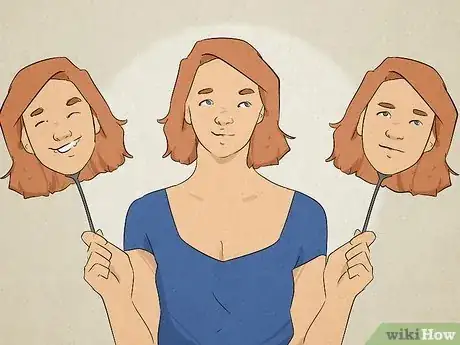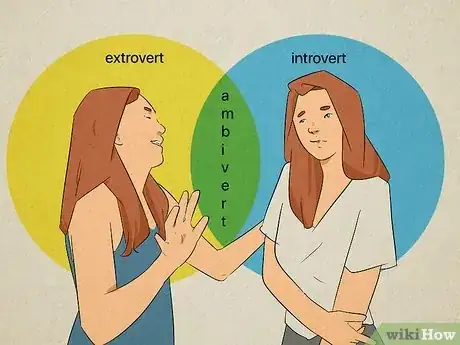This article was co-authored by Leslie Bosch, PhD and by wikiHow staff writer, Hannah Madden. Dr. Leslie Bosch is a Developmental Psychologist, National Board Certified Health and Wellness Coach, and Owner of Bosch Integrative Wellness. With over 15 years of experience, she specializes in providing stress relief coaching services to individuals and groups using a variety of scientifically proven methods for change including motivational interviewing, positive psychology, self-compassion, non-violent communication, social learning theory, and self-determination theory. Dr. Bosch received training from the Andrew Weil Center for Integrative Medicine at the University of Arizona and earned a PhD in Human Development and Family Studies from The University of Arizona. She is also a member of the National Board of Health and Wellness Coaching Association. Dr. Bosch has published many papers and been featured in the media numerous times.
This article has been viewed 3,907 times.
Do you feel like you don’t quite fit the definition of introverted or extroverted? Many people feel the same way, which is why researchers came up with 2 new classifications: omniverts and ambiverts. Since the traits of these personality types are similar, it can be tough to tell which one you are and which label fits you best. That’s why we’re here to tell you all the differences between omniverts and ambiverts, as well as signs you might be one or the other.
Things You Should Know
- Omniverts are either extreme extroverts or extreme introverts, depending on their mood and the situation.
- Ambiverts are in between introverts and extroverts, hovering in between needing a lot of alone time and needing a lot of socialization.
- Omniverts switch between extroversion and introversion drastically, whereas ambiverts are more even-keeled.
Steps
What is an omnivert?
-
An omnivert switches between introvertedness and extrovertedness. Omniverts can exhibit characteristics from both introverts and extroverts depending on their mood that day.[1] X Research source The main characteristic of an omnivert is the extremity of these shifts: one day they are extremely introverted, and the next day they are extremely extroverted.
- Maybe one day they’re very introverted, and just want to spend the day alone recharging. Then the next day, they might want to hang out with a large group of people and meet new friends all day long.
What is an ambivert?
-
An ambivert is in between an introvert and an extrovert. Ambiverts don’t neatly fit the definition of introvert or extrovert. Instead, they hover somewhere around the middle: they appreciate their alone time, but they still like to hang out with friends and chat with new people, too. They aren’t extremely introverted or extremely extroverted; instead, they strike a balance in between.[2] X Research source
- Ambiverts might like spending a few hours on their own, but they quickly get bored and want to be around friends. After a couple hours of socializing, they’re ready to head home and be on their own again.
Differences Between Omniverts and Ambiverts
-
1Social situations Omniverts may thrive in social situations, or they might shrink into themselves. It’s because they’re switching between their introvertedness and their extrovertedness.[3] X Research source On the other hand, ambiverts generally feel comfortable socializing and meeting new people. They might get tired after a couple of hours and head home to recharge and relax.[4] X Research source
- Do you sometimes feel excited about going to a party, but other days can’t bear to talk to anyone new? There’s a good chance that you’re an omnivert. When you’re super excited to go out and make new friends, you’re in your extroverted headspace. And when you can’t leave your room and spend all day alone recharging, you’re in your introverted headspace.
- As long as ambiverts are prepared for it, they’re generally okay with talking to people and being around large groups. They might feel more withdrawn one day and slightly more outgoing the next, but for the most part, they know they can handle any social situation.
-
2Public speaking Omniverts can thrive in a crowd, or it could be their worst nightmare. Again, this has to do with their extreme shifts: one day they’re feeling extroverted and like they could take on the world, and the next day they want to hide from everyone. Ambiverts are nervous about public speaking, but not terrified of it. Since they hover in between introversion and extroversion, they can tap into their extroverted side when they need to.[5] X Research source
- An omnivert might look forward to giving a speech one day and then dissolve into a puddle of nerves the next.
- It might not be their favorite activity, but ambiverts can generally calm their nerves and be confident when it comes to giving speeches or talking in front of crowds.
-
3Professional work Omniverts prefer to work in groups one day and on their own the next. When they’re feeling extroverted, they love to chat with colleagues and brainstorm new ideas; but when they’re feeling introverted, they like to work on their own. Ambiverts, on the other hand, don’t have a clear preference—they don’t mind working in groups, and they also don’t mind tackling things on their own.[6] X Research source
Similarities Between Omniverts and Ambiverts
-
1Recharging and relaxing Both omniverts and ambiverts generally like to rest and recharge alone. They often tap into the more introverted side of themselves when they’re feeling tired or stressed. In both cases, you’ll typically find omniverts and ambiverts staying at home by themselves whenever they’re in a bad mood.[7] X Research source
-
2Small talk For both personality types, small talk isn’t necessarily uncomfortable, but it can get boring after a while. Stereotypically, extroverts love small talk and can chat with anyone about anything. Since omniverts and ambiverts aren’t 100% extroverts, they struggle to maintain the same level of small talk as true extroverts do.[8] X Research source
-
3Public perception Omniverts and ambiverts can be confusing to the people around them. Some might think they’re super social, while others think they’re super quiet. It all depends on which day and what kind of mood you catch them in—they might be feeling more introverted one day and more extroverted the next.[9] X Research source
Signs You’re an Omnivert
-
1You flip flop back and forth between extroversion and introversion. When someone asks “Are you an extrovert or introvert?” do you often find yourself saying, “It depends”? That’s a big sign that you’re an omnivert, because omniverts switch back and forth depending on their mood and the context of the situation.[10] X Research source
-
2When you’re happy, you’re extroverted. Omniverts at their happiest can strike up a conversation with a stranger or go to a party where they don’t know anyone. It’s because they’re lively, upbeat mood matches well with extroversion, and they feel drawn toward other people when they’re feeling that way.[11] X Research source
-
3When you’re unhappy, you’re introverted. If you’re tired, stressed, or anxious, you probably feel the need to curl up in bed with a good book. That’s totally normal—you’re just experiencing your introverted side.[12] X Research source
Signs You’re an Ambivert
-
1You like hanging out with people, but you need alone time, too. There’s nothing you’d rather do on a Friday night than go to a party or out to dinner with friends. After a few hours, though, you’re probably tired and ready to be alone again. It’s this mixture between extroversion and introversion that gives you the perfect balance between being social and being on your own.[13] X Research source
-
2You like being the center of attention, but not for long. Sure, you might tell a joke or two to get all your friends to laugh, but you tend to shy away from anything that puts you in the spotlight for more than a few minutes.[14] X Research source
-
3You’re level-headed and reliable. Ambiverts don’t shift from extreme to extreme, so they’re generally more even-keeled people. They get the best of both worlds, experiencing both the self-reflection that comes with introversion and the social skills that come with extraversion.[15] X Research source
Other wikiHows

 How to Relieve & Prevent Headaches & Migraines Fast
How to Relieve & Prevent Headaches & Migraines Fast
 How to Unclog a Toilet: With a Plunger and without a Plunger
How to Unclog a Toilet: With a Plunger and without a Plunger

 How to Take a Screenshot on a Windows PC: 8 Simple Tricks
How to Take a Screenshot on a Windows PC: 8 Simple Tricks

 How to Take Care of Potted Orchids
How to Take Care of Potted Orchids

References
- ↑ https://www.youtube.com/watch?v=Ys-7gKhk-_o&t=58s
- ↑ https://www.youtube.com/watch?v=mdd74Gjqogo&t=23s
- ↑ https://www.youtube.com/watch?v=Ys-7gKhk-_o&t=113s
- ↑ https://parade.com/1224222/judykoutsky/ambivert-signs/
- ↑ https://parade.com/1224222/judykoutsky/ambivert-signs/
- ↑ https://www.forbes.com/sites/travisbradberry/2016/04/26/9-signs-that-youre-an-ambivert/
- ↑ https://chadqbrown.medium.com/that-depends-are-you-an-omnivert-558f541a1bb2
- ↑ https://www.forbes.com/sites/travisbradberry/2016/04/26/9-signs-that-youre-an-ambivert/
- ↑ https://www.forbes.com/sites/travisbradberry/2016/04/26/9-signs-that-youre-an-ambivert/
- ↑ https://chadqbrown.medium.com/that-depends-are-you-an-omnivert-558f541a1bb2
- ↑ https://chadqbrown.medium.com/that-depends-are-you-an-omnivert-558f541a1bb2
- ↑ https://chadqbrown.medium.com/that-depends-are-you-an-omnivert-558f541a1bb2
- ↑ https://parade.com/1224222/judykoutsky/ambivert-signs/
- ↑ https://www.forbes.com/sites/travisbradberry/2016/04/26/9-signs-that-youre-an-ambivert/
- ↑ https://www.forbes.com/sites/travisbradberry/2016/04/26/9-signs-that-youre-an-ambivert/
About This Article




























































